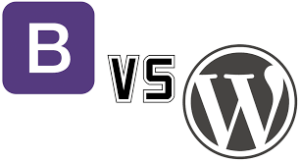Bootstrap vs WordPress
From the time when Internet came into being, websites have been created in HTML, a programming language. These days, the times are changing and with the progress of innovative mobile products a lot of people are looking at options to standard web platforms. There is an increase in demand for web and mobile applications which can be established in a short duration of time to be accessible in the market.
One such common and most used platform for creating fully functional websites and mobile applications is WordPress, a content management system and a theme framework. . The extensively acknowledged open source blogging platform, WordPress has already grown popular as a website designing and development platform. The best thing about WordPress is that it is easy to use and elastic enough for just about everything.
Bootstrap is also another front end framework that facilitates creation of the front end of web sites and web applications. It is a novel and growing website style, offering a great foundation for building full-featured, responsive web applications that can, hypothetically, work on all platforms, and is a wonderful preliminary point for constructing a responsive WordPress theme. A substantial contribution has been provided by Bootstrap in giving a fresh form to the open Source Content Management Systems by incorporating with them and producing special, simple, easy and professional themes and templates that are afterward prepared into classy websites. The websites formed by means of the Bootstrap framework are extremely compatible with all the main web browsers, streamlines open plans, and hustles up the performance of front end web applications.
Though both run exceptionally well, they both have pros and cons and are completely different from each other.
Why and when to use WordPress and Bootstrap?
WordPress is good for everyone, particularly if observed from a big screen system, such as a tablet or computer. Themes for WordPress are more abstract and visually attractive than Bootstrap. The only downside of using WordPress is that the high-end scheme of WordPress makes it consume more memory when loading the pages of the website that may be slower when loading on a phone or other gadget.
Bootstrap, at par with WordPress though, is best suited for smartphones or hand-held devices. Its active design lets the page and text to change size according to the size of the viewing window. This way you can escape side-scroll while browsing the site. As it uses less memory to load than WordPress does, it is suitable for loading on a mobile device.
Advantages and Downsides of theming Bootstrap as a framework for WordPress themes
There are predefined classes in bootstrap that can be used to develop the front end of the web pages that is compatible across browsers and small devices, in turn saving a lot of time.
Few advantages can be listed as below:
- Ease of use
- Highly flexible
- Responsive grid
- Releases frequent updates as compared to other frameworks
- Consistent and uniform across various platforms
However, there are some downsides of using Bootstrap when developing your themes.
- With a lot of styles in it, you have to spend an excessively huge amount of time functioning through all the classes and picking out which ones to select.
- It dampens creative design, as the site design will be centred on what Bootstrap offers, and not on what is needed for your site.
Conclusion
A WordPress theme framework will frequently give you everything you acquire from Bootstrap. Bootstrap is loaded with a lot of structures and therefore needs decent information about bootstrap, HTML, and CSS to accurately harness its supremacy. Also, it saves a lot of time to manually build all the components from scratch. On the other hand, if you are new to programming it is recommended to get your themes made by skilled WordPress designers.





